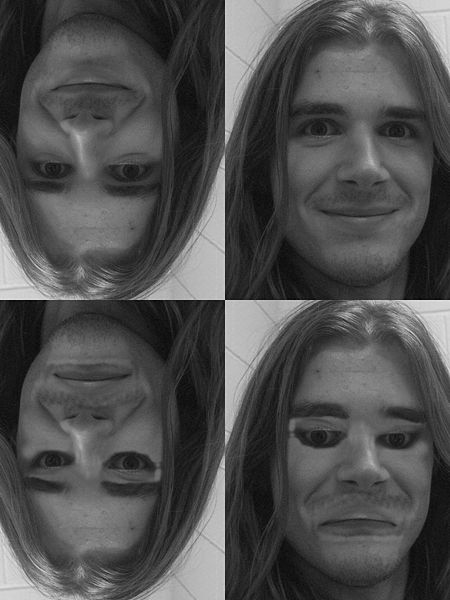Research from Emory University this week shows that we, and our ancestors, have been recognising faces in much the same way for 30 million years or more.
 By watching how Rhesus Macaques respond to a well known optical illusion called the Thatcher effect, professor Robert Hampton and colleagues were able to determine that these monkeys, like us, recognise faces not because we compare them, mentally, to a particular idealised image of a face, but because of the relationship between the different features.
By watching how Rhesus Macaques respond to a well known optical illusion called the Thatcher effect, professor Robert Hampton and colleagues were able to determine that these monkeys, like us, recognise faces not because we compare them, mentally, to a particular idealised image of a face, but because of the relationship between the different features.
The Thatcher effect is an optical illusion that many of you will have seen before - it's created by taking a picture of a face, cutting out the eyes and mouth, then turning them upside down. When you see this image completely upside down (so the eyes and mouth are actually the right way up, but the whole head is rotated), it's hard to see anything wrong with it. It's only when the head is the right way up (meaning the eyes and lips are upside down) that it looks grotesque, and clearly not right.
It's thought that this effect works in humans because we perceive faces as a configuration, rather than an image - this makes us more sensitive to differences in configuration, and makes us more able to recognise individuals.
If monkeys see faces in the same way, then the Thatcher effect should work on them as well.
To test this, the researchers showed some Rhesus macaques some pictures of other Rhesus monkeys' faces, some normal, some upside down and some Thatcherised, and monitored how much attention they paid to each set of images. Once the monkeys had habituated to the photos, they showed no more interest in upside down Thatcherised images than they did normal faces. But when the Thatcherised images were shown the right way up, they paid significantly more attention to them.
This suggests that the monkeys detect faces in the same way as us, as a configuration, and so that this may have evolved at least 30 million years ago, in our common ancestor with the macaques.
Previous studies have shown Thatcherised images to have no effect on pigeons or baboons, which may seem to contradict these results. However, in the baboon study, published in the American Journal of Primatology in 2008, the animals were extensively trained with a small set of images, and so may not indicate the same spontaneous effect as seen in humans.
"This direct evidence of configural face perception in monkeys, collected under testing conditions that closely parallel those used with humans, indicates that perceptual mechanisms for individual recognition have been conserved through primate cognitive evolution," said Professor Hampton.
- Previous Flying dolphins
- Next In-Flight Mind Reading










Comments
Add a comment